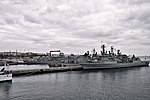Dom Fernando II e Glória

Dom Fernando II e Glória is a wooden-hulled, 50-gun frigate of the Portuguese Navy. She was launched in 1843 and made her maiden voyage in 1845. Built at the shipyard of Daman in Portuguese India, it was Portugal's last sailing warship to be built and also the last ship that undertook the Carreira da Índia (India Run), a regular military line that connected Portugal to its colonies in India since the beginning of the 16th century. The ship remained in active service until 1878, when she made her last sea voyage, having travelled more than one hundred thousand miles, the equivalent of five circumnavigations of the world. After long service it was almost destroyed by a fire in 1963 with the burned wooden-hull remaining beached at the mud-flats of the river Tagus for the next 29 years. Finally in 1990 the Portuguese Navy decided to restore her to her appearance in the 1850s. During the World Exhibition of 1998 the ship remained in Lisbon as a museum ship on the dependency of the Navy Museum, being classified as an Auxiliary Navy Unit (UAM 203). Since 2008, the ship lies on the southern margin of the Tagus river in Cacilhas, Almada.
Excerpt from the Wikipedia article Dom Fernando II e Glória (License: CC BY-SA 3.0, Authors, Images).Dom Fernando II e Glória
Avenida Aliança Povo M.F.A., Almada Cacilhas (Almada, Cova da Piedade, Pragal e Cacilhas)
Geographical coordinates (GPS) Address Nearby Places Show on map
Geographical coordinates (GPS)
| Latitude | Longitude |
|---|---|
| N 38.6860763 ° | E -9.1469498 ° |
Address
Parque de Cacilhas
Avenida Aliança Povo M.F.A.
2800-270 Almada, Cacilhas (Almada, Cova da Piedade, Pragal e Cacilhas, Cacilhas Centro)
Portugal
Open on Google Maps








